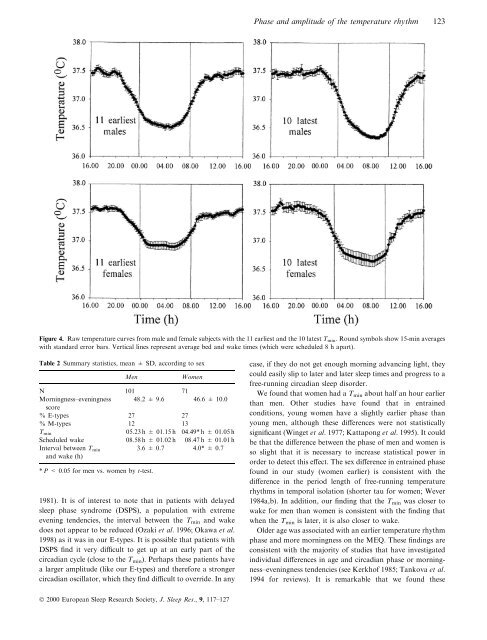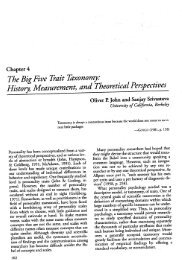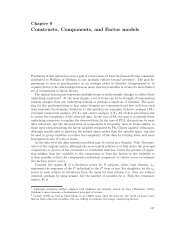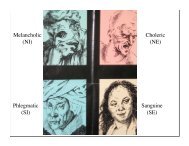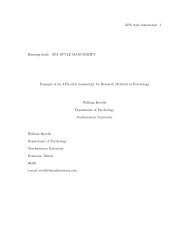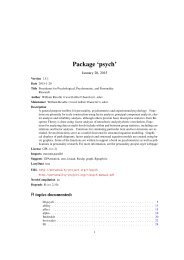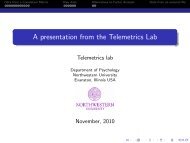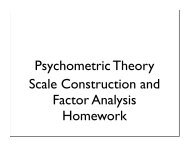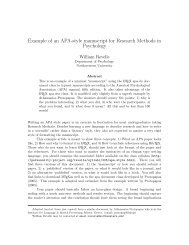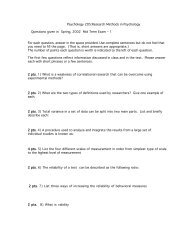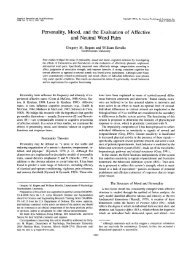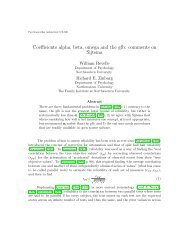Individual differences in the phase and amplitude of the human ...
Individual differences in the phase and amplitude of the human ...
Individual differences in the phase and amplitude of the human ...
Create successful ePaper yourself
Turn your PDF publications into a flip-book with our unique Google optimized e-Paper software.
Phase <strong>and</strong> <strong>amplitude</strong> <strong>of</strong> <strong>the</strong> temperature rhythm 123Figure 4. Raw temperature curves from male <strong>and</strong> female subjects with <strong>the</strong> 11 earliest <strong>and</strong> <strong>the</strong> 10 latest T m<strong>in</strong> . Round symbols show 15-m<strong>in</strong> averageswith st<strong>and</strong>ard error bars. Vertical l<strong>in</strong>es represent average bed <strong>and</strong> wake times (which were scheduled 8 h apart).Table 2 Summary statistics, mean ‹ SD, accord<strong>in</strong>g to sexMenWomenN 101 71Morn<strong>in</strong>gness±even<strong>in</strong>gness 48.2 ‹ 9.6 46.6 ‹ 10.0score% E-types 27 27% M-types 12 13T m<strong>in</strong> 05.23 h ‹ 01.15 h 04.49* h ‹ 01.05 hScheduled wake 08.58 h ‹ 01.02 h 08.47 h ‹ 01.01 hInterval between T m<strong>in</strong><strong>and</strong> wake (h)3.6 ‹ 0.7 4.0* ‹ 0.7* P < 0.05 for men vs. women by t-test.1981). It is <strong>of</strong> <strong>in</strong>terest to note that <strong>in</strong> patients with delayedsleep <strong>phase</strong> syndrome (DSPS), a population with extremeeven<strong>in</strong>g tendencies, <strong>the</strong> <strong>in</strong>terval between <strong>the</strong> T m<strong>in</strong> <strong>and</strong> wakedoes not appear to be reduced (Ozaki et al. 1996; Okawa et al.1998) as it was <strong>in</strong> our E-types. It is possible that patients withDSPS ®nd it very dicult to get up at an early part <strong>of</strong> <strong>the</strong>circadian cycle (close to <strong>the</strong> T m<strong>in</strong> ). Perhaps <strong>the</strong>se patients havea larger <strong>amplitude</strong> (like our E-types) <strong>and</strong> <strong>the</strong>refore a strongercircadian oscillator, which <strong>the</strong>y ®nd dicult to override. In anycase, if <strong>the</strong>y do not get enough morn<strong>in</strong>g advanc<strong>in</strong>g light, <strong>the</strong>ycould easily slip to later <strong>and</strong> later sleep times <strong>and</strong> progress to afree-runn<strong>in</strong>g circadian sleep disorder.We found that women had a T m<strong>in</strong> about half an hour earlierthan men. O<strong>the</strong>r studies have found that <strong>in</strong> entra<strong>in</strong>edconditions, young women have a slightly earlier <strong>phase</strong> thanyoung men, although <strong>the</strong>se di€erences were not statisticallysigni®cant (W<strong>in</strong>get et al. 1977; Kattapong et al. 1995). It couldbe that <strong>the</strong> di€erence between <strong>the</strong> <strong>phase</strong> <strong>of</strong> men <strong>and</strong> women isso slight that it is necessary to <strong>in</strong>crease statistical power <strong>in</strong>order to detect this e€ect. The sex di€erence <strong>in</strong> entra<strong>in</strong>ed <strong>phase</strong>found <strong>in</strong> our study (women earlier) is consistent with <strong>the</strong>di€erence <strong>in</strong> <strong>the</strong> period length <strong>of</strong> free-runn<strong>in</strong>g temperaturerhythms <strong>in</strong> temporal isolation (shorter tau for women; Wever1984a,b). In addition, our ®nd<strong>in</strong>g that <strong>the</strong> T m<strong>in</strong> was closer towake for men than women is consistent with <strong>the</strong> ®nd<strong>in</strong>g thatwhen <strong>the</strong> T m<strong>in</strong> is later, it is also closer to wake.Older age was associated with an earlier temperature rhythm<strong>phase</strong> <strong>and</strong> more morn<strong>in</strong>gness on <strong>the</strong> MEQ. These ®nd<strong>in</strong>gs areconsistent with <strong>the</strong> majority <strong>of</strong> studies that have <strong>in</strong>vestigated<strong>in</strong>dividual di€erences <strong>in</strong> age <strong>and</strong> circadian <strong>phase</strong> or morn<strong>in</strong>gness±even<strong>in</strong>gnesstendencies (see Kerkh<strong>of</strong> 1985; Tankova et al.1994 for reviews). It is remarkable that we found <strong>the</strong>seÓ 2000 European Sleep Research Society, J. Sleep Res., 9, 117±127


